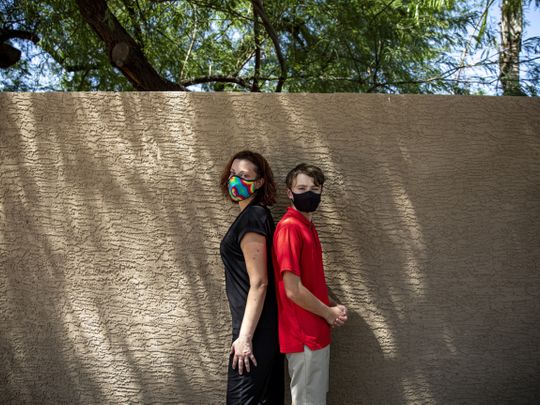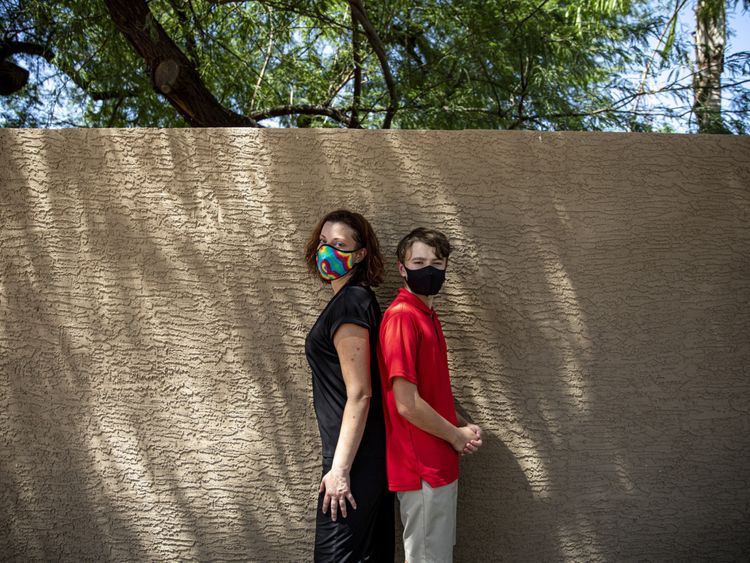
OVERLAND PARK, Kansas: A summer that began with plunging caseloads and real hope that the worst of COVID-19 had passed is ending with soaring death counts, full hospitals and a bitter realization that the coronavirus is going to remain a fact of American life for the foreseeable future.
Vaccination rates are ticking upward, and reports of new infections are starting to fall in some hard-hit Southern states. But Labor Day weekend bears little resemblance to Memorial Day, when the country was averaging fewer than 25,000 cases daily, or to the Fourth of July, when President Joe Biden spoke about nearing independence from the virus.
Instead, with more than 160,000 new cases a day and about 100,000 COVID patients hospitalised nationwide, this holiday feels more like a flashback to 2020. In Kansas, many state employees were sent home to work remotely again. In Arizona, where school mask mandates are banned, thousands of students and teachers have had to go into quarantine. In Hawaii, the governor has issued a plea to tourists: Don’t visit.
“The irony is that things got so good in May and most of June that all of us, including me, were talking about the end game,” said Dr. John Swartzberg, an infectious disease specialist at the University of California, Berkeley. “We started to enjoy life again. Within a very few weeks, it all came crashing down.”
The resurgence has left the country exhausted, nervous and less certain than ever about when normalcy might return.
More than 1,500 Americans are dying most days, worse than when cases surged last summer but far lower than the winter peak. Although the rate of case growth nationally has slowed in recent days and incremental progress has been made in Southern states, other regions are in the midst of growing outbreaks. And with millions of schoolchildren now returning to classrooms - some for the first time since March 2020 - public health experts say that more coronavirus clusters in schools are inevitable.
“No one’s wanting to go back to fight-COVID mode,” said Andrew Warlen, director of the Health Department in Cass County, Missouri, who said some parents had resisted quarantining their students even after they were exposed to someone with the virus.
Vaccines are effective in preventing severe disease and death, but 47% of Americans are not fully vaccinated, allowing the highly infectious delta variant more than enough opportunity to inflict suffering and disrupt daily life. Health officials say that most of the patients who are being hospitalized and dying are not vaccinated and that it is those unvaccinated people who are driving the current surge and burdening the health care system.
“I know a lot of people are feeling this whiplash; you could see the light at the end of the tunnel, and then it was snatched away again,” said Kate Franzman, 36, a director of a nonprofit group who lives in Indianapolis and has started wearing a mask in public once again.
The summer surge has played out in a fatigued, politically divided country with no unified vision for how to navigate the pandemic. During previous upticks, the promise of vaccines led many to think that a return to ordinary life was perhaps just months away and that masking up or staying home was a short-term investment toward that goal. But the virus’s mutations and the refusal of millions of Americans to take the shots have dimmed that hope.
In much of the South, intensive care units are overflowing, and in the Midwest and mid-Atlantic regions, where cases are still rising, governors are bracing for worse days in the coming weeks.
“People ask us sometimes, ‘What’s the end goal here? You’re not going to conquer COVID, and it’s not going to go away forever,’” said Elizabeth Groenweghe, chief public health researcher for the public health department in Kansas City, Kansas. “And I think that really it’s to get to a point where the level of community transmission is at least sustainable and not impacting our daily lives so negatively.”
The question, increasingly, is not how to eradicate COVID-19 but how to manage it. In contrast to the early months of the pandemic, businesses are open, children are returning to classrooms, and sports stadiums are full. Across most of the country, government-ordered vaccine mandates and new lockdowns have been political nonstarters.
A small but growing list of Democratic governors in states including Illinois, Louisiana and New Mexico have required facial coverings in indoor public settings, but most governors from both parties have not. Several Republican-led states have blocked local officials from imposing their own mask mandates.
Signs of delta’s toll abound. Colleges in Virginia and Texas have moved classes online after outbreaks. A hospital in Kansas transferred a patient to Wisconsin because there were no staffed beds nearby. Exhausted hospital employees in North Dakota have been asked to cover extra shifts.
“It’s as if you finish a battle, and before you truly get rested and really thinking about your personal well-being and recovery, you’re thrust back in,” said Dr. Michael LeBeau, president and chief executive for the Bismarck, North Dakota, region for Sanford Health, a hospital system in the Upper Midwest where coronavirus hospitalizations increased 339% over four weeks in August.
Schools are just beginning to open up
Public health researchers described the country’s current state in the pandemic as fragile, and examples from other countries offer few concrete answers about the path forward. Infection levels in India and Britain fell sharply after delta-fueled surges, but cases in Britain have since started to rebound. In Israel, delta has led to a major uptick in cases this summer despite a strong vaccination rate.
In much of the United States, schools are just beginning to open up, although children younger than 12 remain ineligible for vaccines, and mask usage is uneven. Vaccination rates are inching upward as more employers require shots, but 36% of adults are still not fully vaccinated. And breakthrough infections in vaccinated people are becoming more frequent, suggesting that vaccines are losing some efficacy, though they remain highly protective against severe outcomes.
“What worries me the most is not where we’re at, although that’s bad enough, but where we’re headed,” said Andrew Noymer, an associate professor of public health at the University of California, Irvine. “I think the US is still in for a doozy of a next six months. We haven’t seen the effects yet of school reopening.”
Interviews with people across the country revealed a swirl of angst, frustration and resignation over the current state of the pandemic. Some Americans said that, once vaccinated, they were determined to return to the activities they had treasured before the pandemic. Others said they felt stuck in an interminable state of COVID, concerned about the delta variant and newly cognizant of how much time they were spending in public.
But the return of restrictions and mandates has also led to frustration, notably among some vaccinated Americans who questioned why they were facing new rules when so many others had not gotten their shots. Although fully vaccinated people are far less likely to get COVID or to require hospitalization, federal officials have warned that they can still transmit the virus to others if they become infected.
“I hate wearing a mask,” said Sabastien Pavese, 23, a transportation coordinator in Portland, Oregon, where the governor has ordered that face coverings be worn at public gatherings, including outdoors. “I think people should be able to walk around without a mask if they feel like it. I’m vaccinated, and I’m doing just fine.”
Justin Reid, a structural engineer in Meadowbrook, Alabama, has been frustrated by the possibility of a mask requirement in his 4-year-old daughter’s preschool - so much so that he has decided to keep her home if necessary.
“I’m not subjecting her to that when I don’t have to,” said Reid, who said he had been vaccinated.
There will be no immediate fix for the pandemic, experts said, and no promise that the current surge will be the final one.
“I think we’re definitely at risk for being in a very unsatisfying, muddling-though kind of state for a while,” said Dr. Joshua Sharfstein, a vice dean at the Johns Hopkins Bloomberg School of Public Health.
Still, there remains the prospect, as more city councils vote to require face coverings and more people decide to get shots, that the pandemic’s course will eventually feel more upbeat, more like it did when summer started.
“I’m hoping March of next year that we’re having a very different conversation, that we’ve gotten through it,” said Cory Mason, the mayor of Racine, Wisconsin, where masks are once again mandatory. “I think that’s the one thing that everybody agrees on: Can we just get back to a place where COVID isn’t dominating so much of our time and our lives?”













